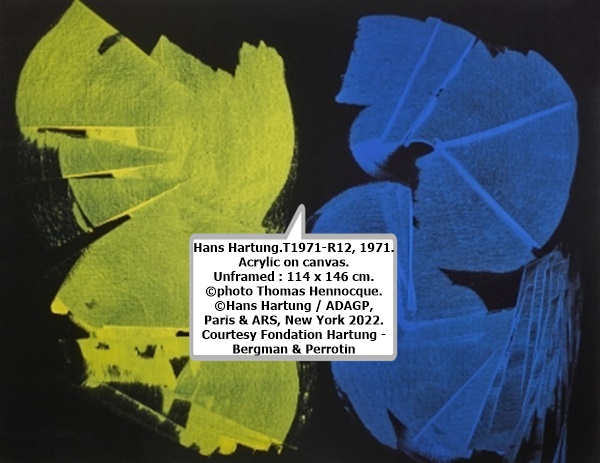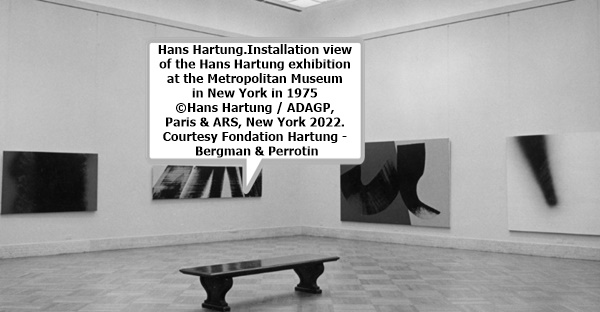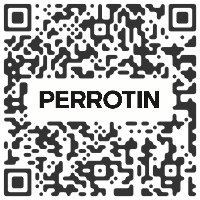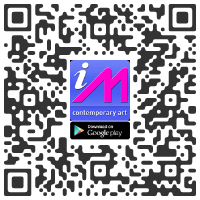"REVENGE"
Hans Hartung

PERROTIN
130 ORCHARD STREET, NEW YORK, NY 10002TEL : +12128122902 e-mail:
Multiple location : Shanghai New York Paris(3) Hong Kong Tokyo Seoul



January 13 > February 18, 2023




Perrotin is pleased to present an exhibition of paintings by Hans
Hartung, pioneer of art informel. The show will take over all three
floors of Perrotin’s New York space with works from the 1970s, a
seminal period for the artist marked by experimentation with tools,
shapes and colors. Titled Revenge, the exhibition seeks to redress
Hartung’s 1975 exhibition at The Metropolitan Museum of Art, which
left the German-French painter woefully underappreciated in the
United States. Opening on January 13, Revenge will recreate a
section of the Met exhibition with paintings that were on view in
1975.
Initially, Hartung’s American reputation seemed guaranteed. His star had been on the rise in the States since the 1930s: collected by Eugene Gallatin and Peggy Guggenheim; ushered into the collection of MoMA by 1952; earning the attention and acclaim of key players like Clement Greenberg and Alfred Barr; and friendship with Mark Rothko. When a Hartung retrospective traveled to Houston in 1969, the critic Ann Holmes referred to him simply as the “Father of Action Painting.” The Metropolitan Museum of Art acquired one of his canvases (T1965- E33) in 1972, paving the way for a major solo exhibition there in 1975.
A few years on from this show at the Met, though, and Hartung’s work would languish in the U.S., more or less rejected and forgotten. He would no longer exhibit in the country. What happened?
To understand, we have to rewind to the mid-1970s, and the lead-up to that Met solo. Hartung’s ambitious and often spectacular practice convinced Henry Geldzahler (then in charge of contemporary art at the Met) that his paintings could more than hold their own on the hallowed New York institution’s walls. 27 paintings, in fact, painted between 1971– 75 and unveiled at the museum on October 16, 1975. All signs pointed to a resounding success; archival photos (on view here at Perrotin) attest to the magnificence of the installation.
In the end, Hartung’s career trajectory in the U.S. would arguably be extinguished by a single man: Hilton Cramer. Already known for having poorly reviewed Philip Guston and Roy Lichtenstein—and knocking Europe down a peg in its cultural competition with the U.S.—the influential critic took to the New York Times to deliver a misguided takedown. Hartung, Cramer wrote on October 18, 1975, represented “one of the most minor and moribund accomplishments of the School of Paris in its period of decline.” Vocal support for Hartung from the likes of Alex Katz, Frank Stella, and James Rosenquist would come too late; the damage, as it were, was already done.
What was Cramer responding to, and what was he so afraid of? It may have been Hartung’s prescient technical chops and willingness to experiment in an unprecedented way. In the ‘70s, Hartung was moving away from a muted palette and dabbling in thrilling new chromatic ranges. Extremely warm, sometimes flirting with a Pop edge, these acrylic tones—orange, yellow, and red, with occasional spurts of pink and purple—were daring, to say the least.
The “Father of Action Painting” was also inventing entirely new tools. Hartung designed his own multi-headed brushes (which would be manufactured for him by the famous company Cléton), and began to create complex compositions with parallel lines that were both rhythmic and labyrinthine. He used various scrapers to literally scratch his surfaces, and playfully (mis)used rollers meant for lithography to obtain transparent, painterly effects. Other unique media—like baryta cardboard, normally reserved for photographic prints—were incorporated. And Hartung fully embraced the plastic, cosmic potential of airbrush painting, generating effects that mirrored popular culture’s obsession with space (most notably Kubrick’s interstellar classic, 2001).
And so, a mere forty-eight years after a boundary-pushing exhibition was unfairly maligned, and five years after Perrotin’s survey exhibition in New York, Hans Hartung will have his revenge. This presentation of works from the 1970s, which includes several paintings that were on view at the Met and archival materials from the period, allows us a chance to travel back in time and renew our understanding of Hartung—both as a historical artist, and one whose bold work continues to speak to our contemporary moment.
Initially, Hartung’s American reputation seemed guaranteed. His star had been on the rise in the States since the 1930s: collected by Eugene Gallatin and Peggy Guggenheim; ushered into the collection of MoMA by 1952; earning the attention and acclaim of key players like Clement Greenberg and Alfred Barr; and friendship with Mark Rothko. When a Hartung retrospective traveled to Houston in 1969, the critic Ann Holmes referred to him simply as the “Father of Action Painting.” The Metropolitan Museum of Art acquired one of his canvases (T1965- E33) in 1972, paving the way for a major solo exhibition there in 1975.
A few years on from this show at the Met, though, and Hartung’s work would languish in the U.S., more or less rejected and forgotten. He would no longer exhibit in the country. What happened?
To understand, we have to rewind to the mid-1970s, and the lead-up to that Met solo. Hartung’s ambitious and often spectacular practice convinced Henry Geldzahler (then in charge of contemporary art at the Met) that his paintings could more than hold their own on the hallowed New York institution’s walls. 27 paintings, in fact, painted between 1971– 75 and unveiled at the museum on October 16, 1975. All signs pointed to a resounding success; archival photos (on view here at Perrotin) attest to the magnificence of the installation.
In the end, Hartung’s career trajectory in the U.S. would arguably be extinguished by a single man: Hilton Cramer. Already known for having poorly reviewed Philip Guston and Roy Lichtenstein—and knocking Europe down a peg in its cultural competition with the U.S.—the influential critic took to the New York Times to deliver a misguided takedown. Hartung, Cramer wrote on October 18, 1975, represented “one of the most minor and moribund accomplishments of the School of Paris in its period of decline.” Vocal support for Hartung from the likes of Alex Katz, Frank Stella, and James Rosenquist would come too late; the damage, as it were, was already done.
What was Cramer responding to, and what was he so afraid of? It may have been Hartung’s prescient technical chops and willingness to experiment in an unprecedented way. In the ‘70s, Hartung was moving away from a muted palette and dabbling in thrilling new chromatic ranges. Extremely warm, sometimes flirting with a Pop edge, these acrylic tones—orange, yellow, and red, with occasional spurts of pink and purple—were daring, to say the least.
The “Father of Action Painting” was also inventing entirely new tools. Hartung designed his own multi-headed brushes (which would be manufactured for him by the famous company Cléton), and began to create complex compositions with parallel lines that were both rhythmic and labyrinthine. He used various scrapers to literally scratch his surfaces, and playfully (mis)used rollers meant for lithography to obtain transparent, painterly effects. Other unique media—like baryta cardboard, normally reserved for photographic prints—were incorporated. And Hartung fully embraced the plastic, cosmic potential of airbrush painting, generating effects that mirrored popular culture’s obsession with space (most notably Kubrick’s interstellar classic, 2001).
And so, a mere forty-eight years after a boundary-pushing exhibition was unfairly maligned, and five years after Perrotin’s survey exhibition in New York, Hans Hartung will have his revenge. This presentation of works from the 1970s, which includes several paintings that were on view at the Met and archival materials from the period, allows us a chance to travel back in time and renew our understanding of Hartung—both as a historical artist, and one whose bold work continues to speak to our contemporary moment.
 | Hans Hartung | |
Opening reception :
March 5, 12 - 8pm
mpefm
U.S.A. art press release
Opening Hours:
TUESDAY - SATURDAY, 10AM - 6PM
You can make an appointment to view the exhibition here.

Opening Hours:
TUESDAY - SATURDAY, 10AM - 6PM
You can make an appointment to view the exhibition here.
QR of this press release
in your phone, tablet













